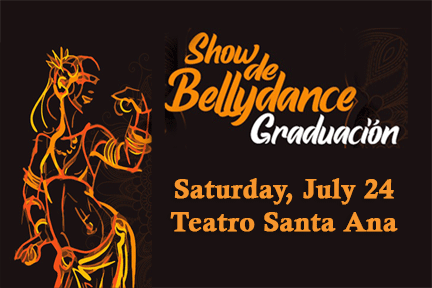Show de Bellydance Graduación/Bellydance Graduation Show [] Teatro Santa Ana at La Biblioteca
Event Category: La Biblioteca and Dance Events
-
Saturday, July 24, 2021
7:00 pmProduced by Elsanne Barrows and Libélula dance studio.
$200 pesos
Teatro Santa Ana at La Biblioteca
“Dance of the Goddess” to be Performed at Santa Ana Theater
by Jenny Purdue
Women begin belly dancing for many reasons, but seldom because they are pregnant. Yet that’s the case with Elsanne Barrows, who primarily danced tango, but needed a dance form she could participate in until her baby was born. Now, nearly ten years later, Barrows has become the recognized expert in teaching “tribal style belly dance” in Mexico.
Barrows teaches a recognized teacher training for this style of dance called “Maestras del Tribal”. This year, graduates of the program hail from Mexico City, Morelia, Toluca, Tijuana, Ensenada, Ciudad Obregon, Durango, and San Miguel de Allende. The Graduation Gala, crowning the course and celebrating the achievement, will present an intricate performance of color, fabrics, intricate and gorgeous arm and body movements at the Santa Ana Theater on July 24th.
Belly dance is more than colorful costumes and sinuous moves, although Barrows says some students buy an entire outfit of harem pants, skirts, heavily decorated belts, and headdresses before their first class.
The intricacy of the moves, however, can be intimidating. Barrows tells how Sandra Cisneros, author of The House on Mango Street, bought an entire month of classes, attended one class, said “Now I know how my students feel,” and never came again.
One of the features of tribal belly dance is interaction and friendship among women who dance together. The group dynamic is an attempt to communicate to each other through the dancers’ bodies, creating a sense of community. Although much of the dance is choreographed, a special form is improvisational, in which the group leader communicates through subtle hand signals and soft sounds which moves and steps will be executed next. Thus, says Barrows, women practicing this style of dance can go almost anywhere in the world and dance with their sister belly dancers.
Little known in Mexico until the last 20 years, belly dance has become extremely popular throughout the country. Originally misunderstood, both in the United States and other Western countries, as a seductive dance women did for men, women now realize that it is a dance of women’s power and unity, danced by women for women.
The costumes are cool, though. Reminiscent of colorful outfits worn by women during the mid-1960s counterculture, Barrows says the present form originates from that time. Tribal belly dancing, as Barrows teaches it, was first seen at early San Francisco Renaissance Faires, and its simplest explanation is women dancing together in groups, rather than singularly, to a more open, improvisational form than it had evolved to. “The women who danced at the Renaissance Faire are the grandmothers of our dance form. The group was called Bal Anat, which means “the dance of the goddess.”
The “counterculture” often seen to have originated in 1965 to early 1967 in San Francisco’s Haight-Ashbury, was an attempt to return to authenticity. Young people, and some older ones, too—alienated by what they called the “plastic” society perhaps best exemplified by Frank Sinatra and the Las Vegas “Rat Pack”; as well as the Vietnam War; and what they considered the artificial values of their parents; sought authenticity in older, traditional forms of dress, values, religion, and natural food.
Tribal belly dance, as Barrows practices it, is also a search for authenticity—not only in teaching the form to beginners as well as other belly dance instructors, but also in her personal values.
“When I am dancing, I am a goddess in training,” she says. The twirling, hip undulating, sweetly seductive arm movement s alone would attest to this. But Barrows means “goddess” in another way, also. “I try to live every part of my life with authenticity,” she says, and rhetorically asks the question, “How do you study to be a goddess?” Her answer is that she experiences a certain spiritual transcendence during the dance, and a spirituality she attempts to carry into every part of her life: that same authenticity she believes people began searching for in the late ‘60s.
Belly dancing, like Flamenco, has obscure and ancient roots. Both originated on the “Gypsy Trail” near India—one part moving toward the Balkans, and the other traveling to Morocco. This explains the frequently Spanish-Moorish look to some of the dancer’s costumes.
Although Barrows says she has always loved dance, she had not visualized herself becoming an expert in belly dance, nor had she imagined it would become the main focus of her life. She was a member of the Peace Corps in her early ‘20s, and her formal background is education. But dance brought a sense of ecstasy: a transcendent energy, she says, that connects her with the Earth, her dance sisters, and the audience.
“This complete connected feeling is about as close to Nirvana as I can get,” she explains.

-
-

